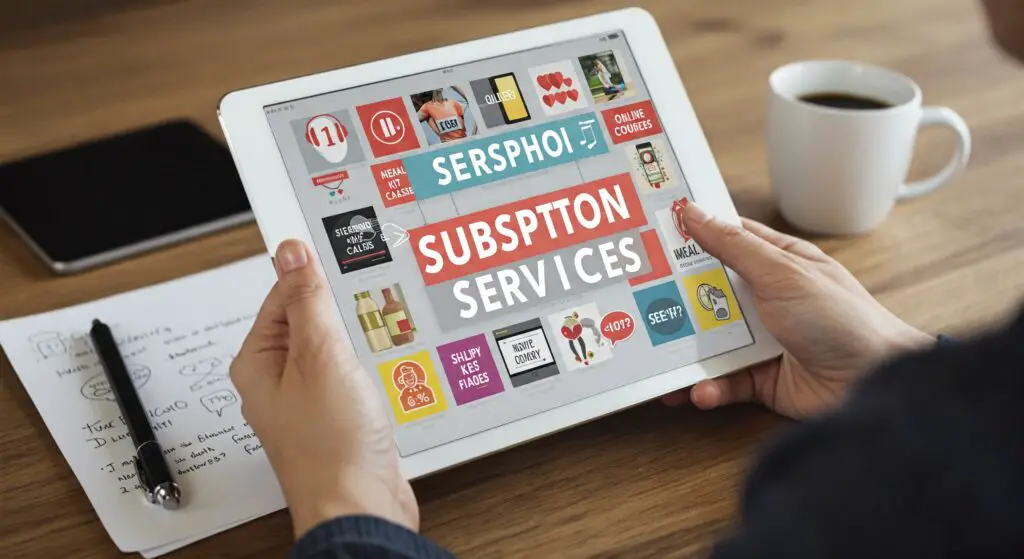
Netflix, Spotify, HelloFresh, Adobe—we’re living in the golden age of subscriptions. And they’re not slowing down.
Subscription businesses are growing nearly 5x faster than the S&P 500. Yep, faster than your favorite tech stocks.
So why do we keep paying every month like it’s on autopilot?
It’s not just convenience or value (though those help).
The real reason? Psychology.
Companies use brain hacks—like habit loops and FOMO—to keep us hooked.
It’s less “choose your fighter,” more “your brain already did.”
In this article, we’ll break down the mind tricks behind your monthly charges and how to break the cycle without canceling everything and moving to a cabin in the woods.
The Rise of the Subscription Model: A Quick Overview
Subscriptions aren’t new—your grandparents had them for newspapers and Reader’s Digest.
But now? They’re everywhere.
We’ve gone from magazines to meal kits, all thanks to the rise of the “set-it-and-forget-it” lifestyle.
Today’s subscription empire includes:
- Entertainment: Netflix, Disney+, HBO Max—basically your social life in streaming form.
- Food: HelloFresh, Blue Apron—because grocery shopping is so 2012.
- Software-as-a-Service (SaaS): Canva, Microsoft 365—your workflow’s best friends.
- Fitness & Wellness: Peloton, Headspace—sweat and zen, now on demand.
- E-commerce: Amazon Prime, Dollar Shave Club—subscriptions for stuff you didn’t know you needed until it arrived.
Quick Stat Check: According to McKinsey, 15% of online shoppers already subscribe to something physical (yes, that monthly razor delivery counts), and the subscription economy is set to hit $1.5 trillion by 2025. That’s “buy a small country” money.
- Read also: Why We Buy Things We Don’t Need: The Psychology Behind Impulse Purchases
- Read also: Is Subliminal Advertising Still a Thing? The Hidden Messages in Marketing

Why We Keep Paying: 7 Psychological Triggers Behind Subscription Loyalty
Subscriptions aren’t just convenient—they’ve tapped into some seriously powerful brain tricks to keep us paying.
Let’s break down the seven psychological triggers that make us stick with subscriptions, even when we know we probably shouldn’t.
The sunk cost fallacy
Once you’ve started paying, even if you’re not using the service, it feels like throwing away money to cancel.
Your brain can’t handle that waste, so you keep going.
It’s like keeping a gym membership “just in case” you suddenly become super fit—even though you haven’t been in months.
Convenience and automation
Subscription services love setting you up on auto-renewal.
Why? Because once it’s set, you don’t have to make any decisions.
You just go on autopilot, saving brainpower for more important things, like what to watch on Netflix.
Behavioral insight: The more you make something easy to keep, the more likely you’ll stick with it. This is called the default effect—basically, we’re lazy, and we like not having to choose.
Loss aversion
We fear losing what we’ve got more than we want to gain something new.
So, when you think about canceling, you imagine missing out on all the cool stuff—new content, perks, whatever.
That’s a powerful brain hack.
Nobel-winning psychologist Daniel Kahneman said it best: “Losing feels twice as bad as winning feels good.”
Personalization and gamification
Services like Spotify, Netflix, and Duolingo know you better than your best friend.
They use your data to make everything feel like it’s made just for you, increasing your emotional connection.
Netflix recommending your next binge? Classic example of personalizing your feed.
Duolingo giving you that streak goal? Brilliant gamification.
The Illusion of Savings
That $9.99/month fee seems harmless, right?
But by the end of the year, that’s almost $120.
Subscriptions trick us by making small payments seem like a deal, even though the total adds up.
And those “Basic,” “Premium,” and “Pro” plans? They’re designed to nudge you toward the middle or high tiers.
Insight: It’s all about anchoring—getting you to mentally compare options and choose the one that looks “reasonable” compared to the top-tier one.
Endowment effect
Once you “own” a service—even if it’s just a free trial—you start to feel like it’s yours.
That’s the endowment effect, and it makes us value things more just because we have them.
Ever start a free trial and suddenly feel like you need that streaming service? Yeah, that’s the effect in action.
Study alert: A 2007 study found people valued things they had, even for a short time, way more than identical items they didn’t possess. So, enjoy your free trial while it lasts.
Social Proof and FOMO (Fear of Missing Out)
If everyone you know has Spotify Premium, how likely are you to cancel yours? Not very, right?
Social proof—seeing your friends and influencers using something—creates pressure to not opt out.
You don’t want to be the one person without it.

Subscription Business Strategies Backed by Psychology
Subscription businesses don’t just sell a service—they use psychology to keep you hooked.
Here’s how they do it:
Freemium models
Ever tried a free app, only to find yourself paying for the full version a few weeks later?
That’s the freemium model at work.
Here’s the psychological magic behind it:
- Reciprocity: When something’s given to us for free, we feel the urge to return the favor. So, businesses offer a taste for free, then nudge us toward upgrading.
- Commitment: Once you’ve invested time (or used the free service), it’s harder to let go. It’s like Netflix’s “Are you still watching?”—once you’re in, you’re committed.
Seamless sign-up, tricky cancellation
Joining a service? Easy.
One-click sign-up? Sure, why not?
But canceling? That’s a whole different story.
Companies make it simple to start, but hide the cancellation options deep in account settings.
Why? It’s all about inertia.
The harder it is to quit, the more likely you are to stick around.
It’s like ordering something on Amazon Prime—getting the “Buy Now” button is a breeze.
But canceling? That requires like three clicks and a CAPTCHA test.
Continuous updates and “Drip” features
One thing subscription services love is keeping things fresh—always.
They promise new content, features, or updates, so you’re never bored.
It’s all about that sweet “variable reward” system, a concept borrowed from the unpredictable nature of slot machines.
You never know what’s coming next, but you’re pretty sure it’ll be good.
Netflix is a master of this. They drop fresh content every week, making sure your next binge is just a click away.
How to Make Conscious Choices as a Consumer
Subscriptions can be super convenient, but are you the one in control, or is your brain being played like a bad sequel?
It’s time to take charge of your choices.
Here are some simple, actionable tips to make sure you’re not just mindlessly clicking “subscribe”:
Audit your subscriptions monthly
Think of this like a Netflix “Are you still watching?” moment for your finances.
Use apps like Truebill or Bobby to get the lowdown on all your subscriptions.
These apps help you spot the ones you’ve forgotten about (like that gym membership you haven’t used since January).
Evaluate usage vs. cost
It’s easy to keep paying for things you don’t use—like that fitness app you haven’t touched since the first week of the new year.
Take a moment to check if the value you’re getting is worth the cost.
If you’re not using it, consider cutting it loose like a bad habit.
Cancel before the trial ends
Free trials are a trap disguised as generosity—like that 30-day gym pass you never used.
Set reminders to cancel your trials 1-2 days before they auto-convert to paid plans.
This gives you time to decide whether you’re really getting your money’s worth.
Avoid auto-renew when possible
Opt for manual renewals instead of auto-renewing subscriptions.
That way, each time you pay, you’re making a conscious decision, not just letting things roll on by default.
Your brain (and wallet) will thank you for it.
Bundle wisely
If you’re using multiple services, consider bundling them.
For example, Amazon Prime gives you everything from fast shipping to streaming—why pay for five separate services when one covers it all?
Bundling can save you both money and decision fatigue.

The Flip Side: Why Subscription Services Work for Businesses
For businesses, subscriptions are like finding a hidden treasure chest.
The recurring revenue model provides serious advantages, including:
Predictable cash flow
When customers sign up for a subscription, businesses don’t just make one sale—they secure a steady stream of income, month after month.
It’s like having a “money machine” that keeps running, even while you’re binge-watching your favorite series on Netflix.
Higher customer lifetime value (CLV)
With a subscription, businesses make more money over time.
Rather than a one-time sale, customers are locked in for a longer period, driving up their lifetime value.
It’s like when your favorite fast food joint offers that “meal plan”—they get you hooked, and you’re back every week.
Deeper customer insights
Every month, every click, every purchase provides data.
And with subscriptions, businesses can track customer preferences, behavior, and usage.
This data is like superpower fuel for personalized marketing and product improvements.
Imagine if Spotify knew exactly what songs you wanted to hear before you did—oh wait, they do.
Scalability without constantly acquiring new customers
Once a business has a solid base of subscribers, they don’t need to hunt for new customers constantly.
Instead, they focus on keeping the ones they’ve got happy and engaged.
It’s like running a successful YouTube channel—focus on growing loyal fans who keep coming back, rather than trying to grab everyone off the street.
Stat Alert: According to Harvard Business Review, increasing customer retention by just 5% can boost profits by anywhere from 25% to 95%. It’s not just about getting new customers—it’s about making sure your existing ones stick around.
- Read also: The Science of Selling: Psychology of Color in Advertising
- Read also: Consumer Behavior: Post-Purchase Cognitive Dissonance
Conclusion: Understanding the Mind Behind the Model
Subscription services aren’t just about products or prices—they’re about how we think.
By using clever psychological tricks like loss aversion, sunk cost fallacy, and the endowment effect, companies turn convenience into loyalty—and loyalty into cash.
Knowing these tricks lets you make smarter choices.
Whether you’re trying to manage your own subscriptions or build a brand, understanding this psychology gives you the upper hand.
It’s like learning the magician’s secret—you can decide whether to keep enjoying the show or take back control of your wallet.



